While economy brands like Hyundai and Toyota have been in the hybrid and electric game for some time, it has taken the luxury giants a little longer to get their ducks in a row. Some have definitely tried their hand at it, but read any BMW i3 review and you’ll see that they haven’t had the best luck. The small electric hatchback was all over the place in terms of style, function, and quality, besmirching the name of the German automaker. Luckily, this hasn’t discouraged the company, nor its competitors. Now, the new BMW iX is on the horizon, and Mercedes-Benz has begun introducing its EQ range in response.
Alongside the Audi e-tron and Volvo XC40 Recharge, these are true luxury EVs that bring all the benefits of a Tesla to the premium segment. This includes unbeatable fuel economy ratings, excellent performance, and all the latest in infotainment and driver-assistance features. Add to this their attractive styling, upscale interiors, and focus on refined driving, and they may very well be the most impressive vehicles in the world.
Something for everyone
While the hatchback i3 may not have been particularly popular, the luxury automakers are working to fill up every classification with EVs of various configurations. If you desire a sedan, the BMW i4 or Genesis G80 Electric are great options, though most manufacturers are electrifying their existing ranges, so there should be no shortage of options. For coupes, there is already the Porsche Taycan, but the upcoming Genesis Essentia is easily one of the most attractive future cars.
Electric powertrains are known for their excessive horsepower and torque outputs, so it’s no surprise that many automakers are looking at hypercars. The Aspark Owl and Lotus Evija are perfect examples of this, with top speeds nearing the 300 mph mark and break-neck acceleration times. As for the most popular market in the USA, pickup trucks, Ford, GMC, Ram, Chevrolet, and Bollinger are all bringing something to the table. There are even a few wagons on the cards, such as the Lagonda All-terrain.
But, without a doubt, the body styles getting the most attention are definitely the SUV and crossover. Kia, Hyundai, and Honda will be covering the cheaper side of things, while BMW, Mercedes-Benz, Volvo, Fisker, and Cadillac models appeal to those who have a little more cash to burn. Let’s take a closer look at some of the top contenders.
BMW iX
As one of the leading names in both luxury and performance, BMW has a reputation to live up to. It also has to make up for the failure of the i3. Using the same nameplate, the iX supersizes things by going the SUV route. It slots into the midsize category, being about as long as the X5 and sharing the same height as the X6. However, it borrows styling choices from the X7, making it a true amalgamation of all BMW’s biggest hits.
Add to this a 496-hp powertrain and refined handling dynamics, and it’s no surprise why everyone is excited about the new iX. Thanks to its impressive size, it comfortably seats up to five passengers, and there is more than enough room in the back seat for adults. Cargo space isn’t lacking either, although official figures aren’t out yet.
Audi e-tron
Audi was one of the first luxury brands to make a mark on the EV segment, and the e-tron definitely makes a good impression. Available in a standard SUV configuration or a sleeker Sportback edition, the e-tron is a very good-looking car. Its EV characteristics aren’t quite as refined as, say, a Tesla, but you can’t fault its quality.
The cabin is dressed in the finest materials, and there are loads of standard features. In fact, there may be a little too much tech, as the infotainment is overly complex and some of the controls aren’t as intuitive as they could be. Nevertheless, it’s a great alternative for shoppers who feel that the Tesla Model X or Y simply don’t have enough character.
Polestar 2
Though technically not a Volvo, the Polestar 2 draws a lot of inspiration from the Swedish brand. This is because Polestar is the in-house tuning department for Volvo, having given us the Polestar variants of the S60, V60, and XC60. Now, as a Brand in its own right, Polestar has released the Polestar 2 sedan, a follow-up to the Polestar 1 coupe. The former was an ultra-high-priced and ultra-luxurious exotic sports car, but the next-gen sedan is more of a premium everyday driver.
It’s still extremely well-styled and has more than enough power to get around in a hurry. Of course, it replaces the gas engine with a purely electric one, too, for unbeatable mpg figures and instant torque responses. This allows it to silently sprint to 60 mph in just 4.5 seconds. Inside, you get the same level of refinement you’d expect from any Polestar Volvo, though the quest to make everything from sustainably sourced materials means that it isn’t quite as plush as what the Germans offer.






































